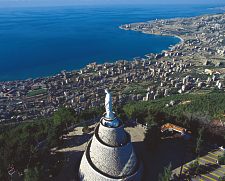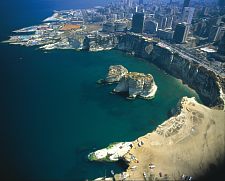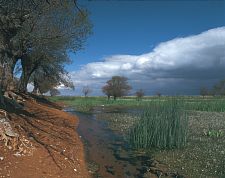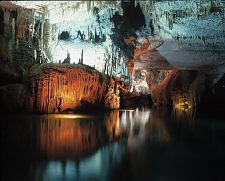|





| |
Democracy in Lebanon: Anatomy of a Crisis
by
Ghassan Tuéni*
Lebanese
Center for Policy Studies |
The Beirut
Review - Fall 1993
Table of Contents
To understand the crisis of democracy in Lebanon, it may be important to go
back to the roots of our democratic experiment rather than merely analyze,
ex-nihilo, its present malfunctioning.
Lebanon's democratic system was not born with independence half a century ago as
is commonly believed, particularly by the younger generations. What was born, or
formulated, in November 1943 was the National Pact, an unwritten
constitution, though it was not described as such. The Pact introduced
amendments to the 1926 constitution - which had been amended in 1929 - that
suppressed the position and functions of the French High Commissioner as the
mandatory power's all too powerful representative, but that did not, wittingly,
touch upon the prerogatives of the legislative or executive institutions or any
of their functionaries.
Indeed, it is pertinent to note that Lebanon's parliamentary republican system
after 1943 remained exactly what it had been before independence. The separation
of powers, as practiced, did not actually conform to the letter of the
constitution, nor did it impose a system of checks and balances as was intended.
Yet nothing was done to correct this. In fact, it was the evolving exercise of
power that changed the system set in place since the constitution's inception,
as the evolving nature of confessional representation had changed what we call
today the "three presidencies": the presidency of the Republic, for example,
went to Greek Orthodox representatives in 1926 (Charles Debbas) and in 1943 (Petro
Trad), but more frequently it went to a Maronite, and this became the rule; the
prime ministership, which went to a Maronite originally, was held by a Sunni
representative (Khayr al-Din al-Ahdab) after 1937; the speakership of
parliament, which went to a Sunni representative between 1927-1929 (Shaukh
Muhammad al-Jisr), and sometimes a Maronite, went finally to a Greek Orthodox
until 1943. In this context, it is important to note that article 95 of the
constitution, which dealt with the "temporary observation of confessional
representation in the selection of public officers," was not seriously modified
in the written and unwritten constitutional amendments introduced in 1943, and
the proclaimed objective of "deconfessionalizing" the system remained elusive.
Observers concur that, quite to the contrary, confessionalism, even in the
appointment of the lowest echelons of government, became a permanent fixture of
Lebanese democracy.
The Roots of Lebanese Democracy
Lest it be assumed that republicanism, or representative government, and the
creation of a Grand Liban were gifts from the French Mandate, established by the
League of Nations in 1919, it is imperative to remember the following:
(1) Inasmuch as a republic is a development of res-publica, literally a
"common wealth," modern Lebanon is heir to the various forms of popular
representation which it alone enjoyed within the framework of a limited
political autonomy under the Ottoman Empire since the early seventeenth century,
long before the concept of the democratic nation-state was universally adopted.
It is of particular importance to cite here two forms of civic, or popular, if
not national pacts: the Dayr al-Qamar and Antelias Ammiyahs (in 1810 and 1840,
respectively), or popular proclamations, which stated principles of political
conviviality in defense of Lebanon's freedom. Both were remarkable in their
candor and simplicity when measured by some contemporary political thinking and
behavior.
It is useful to point to early examples of Lebanese populism, not altogether
untainted by remnants of feudal representation: the peasants' revolt of Yusuf
Karam (1866); the secret societies of the late 1880s whose activities continued
in exile up to the proclamation of Lebanon's independence in 1919; and the forty
martyrs hung in Beirut between 1915 and 1916 - all liberal democratic thinkers
and leaders - representing, one is tempted to say, the various Christian and
Muslim communities, and whose deaths were a supreme expression of national unity
in the struggle for independence from the Ottomans.
(2) A second component of Lebanon's historical democracy relates to its borders.
Contrary to popular belief, the present "natural" boundaries of the Republic -
which were consecrated by the Versailles Conference and later by the League of
Nations - were first drawn in December 1918 by the Administrative Council under
Habib Pasha al-Sa`ad. These boundaries were officially proclaimed by the French
High Commissioner General Gouraud on September 1, 1920, and subsequently were
approved by the 1922 Representative Council, a body elected on the basis of
confessional representation. Of course, one can also find an early hint of
Lebanon's natural borders in the imarah of Prince Fakhr al-Din II
(1572-1635), whose rule over Mount Lebanon took him to Beirut, Sidon, the Akkar,
and even further north, far into the Syrian provinces. Hence no other state in
the Middle East can claim a more democratic definition of its borders.
(3) For centuries Lebanon has had a tradition of bipartisan rivalry which, at
times, deteriorated into warring factionalism: during the Qaisi vs. Yamani,
Yazbaki vs. Junblati, and even "pro-Kussa" and "anti-Kussa" confrontations in
the 1870s and 1880s, bipartisan politics re-emerged - almost along village lines
- in successive electoral and parliamentary alliances during the mandate era,
and, subsequently, in the rivalry between the National Bloc under Emile Eddé,
and the Constitutional Bloc under Bishara al-Khouri.
One must emphasize that whereas the two traditional blocs had a broad base in
all religious communities, since the 1950s Lebanese parties became increasingly
confessional, and products of local electoral, and hence, confessional
alliances. The last significant parliamentary group that continued to have a
multi-confessional base was the 1951 Socialist and National Front, which was a
unique and never re-created coalition including Kamal Junblat's Progressive
Socialist Party, Camille Chamoun's National Liberals, the Parti Populaire Syrien
(PPS), the National Bloc, and the Armenian Hentchak party. The Front's eight MPs
(in a parliament of seventy-seven members) led the first "White Revolution" in
the Arab world which brought about the downfall of President Bishara al-Khouri's
regime in September 1952. It was a unique instance in democratic history: a
parliamentary minority succeeding in exercising such overall popular appeal,
even in areas where it held no parliamentary seats, that it eventually called
for a general strike and was able to reverse the sentiment in parliament. The
president was forced to resign, and the candidate of the opposition, Camille
Chamoun, was almost unanimously elected to the presidency by the very parliament
of which his group was only a minority.
From the Historical to the 'Evil' Compact
The 1943 National Pact and the historical compact which preceded and subsumed it
were imperiled by the most undemocratic practices witnessed immediately after
1943, despite independence and the reforms it was supposed to herald.
It would take a long time to list the abuses of power - all justified as being
in defence of Lebanon's newly-acquired independence - which culminated in the
rigged elections of 1947 and the election of President Bishara al-Khouri to an
unconstitutional second term, even before his first six-year term expired.
Lebanon's constitutional checks and balances were rendered powerless, but
democracy was nevertheless salvaged by the White Revolution of 1952 at a time
when, throughout the Middle East, military coups d'état were undertaken to
"correct" so-called immature exercises in democracy.
The emergence of 'military society' in the Arab world, and its edulcorated
Lebanese version embodied in Chehabism, are too well-known to be discussed here.
Suffice it to say that those who embraced Militocracy felt impelled to
seek an alibi for government by violence, whether this was manifested in
the post-revolutionary creation of revolutionary parties and progressive
party doctrine as in Egypt, or through the hijacking of existing minority
revolutionary parties - for example the Ba`th - by military clans in Iraq and
Syria. Similarly, in Lebanon the non-partisan General-President Fouad Chehab,
who was elected by a slim parliamentary majority, allowed - some say encouraged
- the army to become "the party of the state" and directly, or indirectly,
control to the government, the public administration, and politics.
A careful analysis of the mis-exercise of democracy in Lebanon leads us to a
number of conclusions:
The checks and balances established between the executive and legislative
branches were made inoperative by an 'evil alliance' between the two, and this
took two forms:
- The first flowed from the executive towards the legislative branch of
government: by practicing extensive nepotism and confessional favouritism, to
the detriment of the rule of law, a corrupt undemocratic executive could secure
re-election for its party or group in parliament. Hence, instead of emerging
from a parliamentary majority, the governing clique "elected" its own majority,
and thus could theoretically perpetuate its power unless a major crisis caused a
para-constitutional emergency which brought about a change, usually through the
dissolution of parliament, the appointment of a neutral coalition or even an
opposition government, and the announcement of new elections. The dimension of
the change, and its constitutional consequences, were inversely proportional to
the importance and effectiveness of the president who was the guarantor of the
constitution.
The second form of this 'evil alliance' flowed from the legislative towards the
executive: because of the executive's control of electoral results and its
generous dispensation of favours, parliament tended to act with complacency
towards the former's actions, and save for some formal inconsequential
oratorical performances, it avoided censoring the executive. Electoral laws,
which were readjusted by self-serving legislatures with the complicity of the
executive, were never allowed to reflect socio-political change, popular
aspirations, and the emergence of new classes or political forces.
The stagnation of so-called democratic government, and its inability to exercise
leadership, particularly in the socio-economic development of the country, were
due to an ever-increasing divorce between the ruling clique and the emerging
classes. Lebanese democracy was not only cut off from its historical and
political roots, it was left floating in a cultural vacuum. Not only was there
no genuine democratic society to nurture and renovate constitutional
institutions, including political parties, parliamentary blocs, and the civil
service, but the very ideals of liberal democracy were thrust aside by the
onslaught of authoritarianism and violent change.
The last, but by no means the least of the "compacts" which emanated from the
National Pact, and which helped transform Lebanese political society, was the
accession to full power-sharing of the urban Sunni Muslim leadership and elites.
Reluctant before independence in 1943 to recognize Lebanon as a homeland, the
urban Sunni Muslim leadership's new commitment reduced the role and influence of
the rural alliance between the Maronites, the Druze, the Shi`a, and their
powerless - some say rootless - minor Sunni allies who enjoyed limited
popularity within their own community, and who could not be expected to
significantly project their community's aspirations and interests in the system.
The participation of the Sunni elites in Lebanon's leadership not only changed
the theatrics of the new governing alliance, but transformed its economic
interests, its objectives, its social outlook, and even its internal and
external economic policies. Tremendous, though at times slow, change occurred,
moving the Lebanon of 1943 away from an economy based exclusively on tourism,
services, trade, craftsmanship, and agriculture that had shaped its modest image
under the French Mandate. A new middle class was born which, along with the
growing professional and intellectual classes, was soon to become the real
social foundation of the new democracy.
Yet, Lebanese pluralism had one positive effect: the balance between the
multiple components of Lebanon's "confessional society" was a barrier against
the emergence of a dictatorship. The paradox is that the principle of the
separation of powers between Lebanon's governing institutions was progressively
replaced by the strangest of innovations: a "distribution of powers" between the
communities which prevented government by one group, be it a majority or a
minority, over the whole. The presidency became a Maronite power, not merely an
institution held by a Maronite; the prime ministership became both Sunni
government and effectively, a government of Sunnis; and the speakership of
parliament soon ceased to be anything but the representation of emerging Shi`a
power, to the detriment of its constitutional role as a guardian and regulator
of parliamentary life and legislative reforms. What we now refer to as
government by consensus had its roots in this body of unwritten constitutional
practices.
The Regional Dimension of a Future Compact
Since the 1943 National Pact was a reflection of the fragile balance between
conflicting confessional visions, as well as a mirror-image of the international
and regional forces which inspired them, the survival of Lebanon's democracy
would come not only to rest on faithful implementation of the unwritten pact,
but would ultimately depend on the continued good will and stability of the
external environment which helped nurture it. And therein lay one of the many
seeds of its failure. The covenant, because of the laxity of the leadership
responsible for implementing it, would prove especially impervious to the
demographic and social changes visiting Lebanese society, while Lebanon's
consociational democracy would prove especially sensitive to the vicissitudes of
the region.
The 1943 formula, which consecrated Christian recognition of Lebanon's belonging
to the Arab world and Muslim endorsement of its independent statehood, was
essentially a confirmation of the tremendous influence external factors
exercised over Lebanon's internal politics. Lebanese democracy could only be
expected to grow stronger in a stable and supportive regional environment.
Instead it became a casualty of regional turbulence and foreign interference.
The conflictive structures which defined Lebanese democracy unwittingly
conspired to reduce the country to a mere vent hole for regional conflicts. The
national covenant, originally an expression of confessional consensus, became a
symbol of stasis. Lebanon's democratic institutions, which were intended
to help prepare for the race towards economic progress and stronger democratic
rule, became vehicles for the clashing interests of regional powers and their
local pawns. The Lebanese parliament deteriorated from being a forum for
partisan competition and debate into one for partisan confrontation. And, most
significantly, Lebanese political parties, through ideological affinities or
financial incentives, genuine fears or pure cynicism, ceded their decisionmaking
capabilities to their so-called foreign allies. Gradually, the issues at stake
for the Lebanese ceased to be Lebanese issues.
Needless to say, Lebanon was not the only country in the area that felt the full
brunt of the Arab-Israeli conflict and that played host to the battles between
warring regimes and regional alliances vying to impose their own versions of the
path to victory and salvation. But democratic Lebanon - unlike all the other
Arab regimes, which adopted alternative, less democratic, methods of rule -
became the weakest and most welcoming of hosts for the area's colliding
currents. As a result, the slide towards civil war became irreversible.
Today, after seventeen years of vicarious wars, the 1989 Taif Agreement is
championed as a cure for Lebanon's past ills. Taif - the most notorious
innovation of which was the transfer of executive power from the president to
the council of ministers - was meant to pave the road to peace and strengthen
Lebanon's resistance to foreign manipulations. However, we soon discovered that
Taif was only a transient arrangement substituting for a much needed long-term
solution.
The Troika, the "innovative" triangular meeting of minds between the president,
the prime minister, and the speaker of parliament - together representing the
three major components of the country - has no constitutional mechanism through
which it can find permanent legal support. Although we celebrate this new form
of "collegial government" as proof of a new concord, we are nonetheless aware
that it is a very thin and transparent cover for a political discourse taking
place over hidden agendas. Meanwhile, the country floats in a state of limbo,
and national development continues to be postponed indefinitely due to often
minor and sometimes ridiculous conflicts of interest within Lebanon's triangular
leadership.
Following in the tradition of the 1943 National Pact, the Taif agreement linked
Lebanon's internal well-being to external conditions. It called for the
withdrawal of Israeli forces from Israel's self-declared "security zone" in
South Lebanon (Resolution 425), and the redeployment of Syrian troops. It also
stipulated the creation of an Arab/International Fund for the reconstruction of
Lebanon, and rejected the permanent settlement of Palestinian refugees on
Lebanese territory.
Obviously, the fulfilment of these four pre-conditions for the return of
Lebanese independence and the full exercise of Lebanese sovereignty was not in
Lebanese hands. All four conditions were contingent upon the Middle East peace
process, which local players erroneously assumed was already well under way.
Lebanese democracy, therefore, could be restored only if all the parties
involved in the process - the U.S., the European states, the Gulf states, Syria,
and even Israel (all visible or invisible partners in the Taif agreement) - were
willing to cooperate and invest in Lebanon's internal peace, security, and
reconstruction. So far, however, this has not proved to be the case.
The fact that a comprehensive Middle East peace was not forthcoming further
exposed the ongoing discord in Lebanon. In fact, the petty hagling taking place
at present over the implementation of new constitutional provisions is merely a
cover for regional struggles reaching as far away as Iran. What more do we need
to be convinced that even the proper exercise of constitutional democracy in
Lebanon will have to wait for a balance of power, not between the executive,
legislative and judiciary authorities, but between the conflicting parties
competing for regional hegemony?
* Ghassan Tuéni is one of Lebanon's foremost statesmen and
political writers. He was Lebanon's ambassador to the United Nations, and is
publisher of the Lebanese daily al-Nahar. He is also currently the chairman of
the Executive Committee of Balamand University.
Back to Top of Page
|